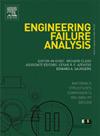Simulation-based failure analysis of faulty and regulatory railhead repair welding procedures
IF 5.7
2区 工程技术
Q1 ENGINEERING, MECHANICAL
引用次数: 0
Abstract
Advancements in railway technology have significantly reduced wheel and axle failures, yet rail failures, particularly in welded regions, remain a major concern. Up to 60% of recorded rail failures occur in these areas, with accident reports frequently attributing incidents to improperly executed repair welds. Using thermo-metallurgical-mechanical finite element simulations, this study investigates the mechanical performance of regulatory and faulty in-situ railhead repair welds, where only part of the railhead is removed. The multi-pass welding simulations employ a multi-phase homogenization-based material model, incorporating non-linear isotropic and kinematic hardening, phase transformation kinetics, and virgin material state recovery. Mechanical performance of the railhead repairs is evaluated through wheel-rail contact over-rolling simulations and fatigue analysis using novel multi-phase Dang Van criterion.
The comparison, based on quantitative data, reveals an increased risk of fatigue crack initiation when deviations from the regulatory procedure occur. The regulatory repair produces a ferritic-pearlitic microstructure and a more favorable residual stress state, characterized by compressive stresses in the weld region and tensile stresses deeper below the rail surface where the microstructure is more favorable. In contrast, the faulty repair exhibits rapid cooling rates, leading to brittle martensitic phases and high tensile residual stresses near the rail surface, significantly increasing fatigue crack initiation risk. Operational over-rolling simulations further demonstrate that tensile stresses in the faulty repair persist near the surface, failing to redistribute as effectively as in the regulatory repair. These findings underscore the importance of strict adherence to repair welding standards to prevent premature rail failures and costly maintenance interventions.
基于仿真的故障与规范铁路道口修复焊接过程失效分析
铁路技术的进步大大减少了车轮和车轴的故障,但铁路故障,特别是在焊接区域,仍然是一个主要问题。有记录的铁路故障中,高达60%发生在这些地区,事故报告经常将事故归咎于不正确的修复焊接。使用热冶金机械有限元模拟,本研究调查了规范和故障的原位铁路栏杆修复焊缝的机械性能,其中只有部分铁路栏杆被移除。多道次焊接模拟采用基于多相均质化的材料模型,结合非线性各向同性和运动硬化、相变动力学和原始材料状态恢复。采用新颖的多相Dang Van准则,通过轮轨接触过滚模拟和疲劳分析,对钢轨修复的力学性能进行了评价。基于定量数据的比较表明,当偏离规范程序时,疲劳裂纹萌生的风险增加。调节修复产生铁素体-珠光体微观组织和更有利的残余应力状态,其特征是焊缝区域的压应力和钢轨表面以下更深的拉伸应力,那里的微观组织更有利。相反,缺陷修复表现出快速的冷却速度,导致钢轨表面附近的脆性马氏体相和高拉伸残余应力,显著增加了疲劳裂纹萌生的风险。操作过滚模拟进一步表明,故障修复中的拉伸应力在表面附近持续存在,无法像规范修复中那样有效地重新分配。这些发现强调了严格遵守修理焊接标准的重要性,以防止过早的轨道故障和昂贵的维护干预。
本文章由计算机程序翻译,如有差异,请以英文原文为准。
求助全文
约1分钟内获得全文
求助全文
来源期刊

Engineering Failure Analysis
工程技术-材料科学:表征与测试
CiteScore
7.70
自引率
20.00%
发文量
956
审稿时长
47 days
期刊介绍:
Engineering Failure Analysis publishes research papers describing the analysis of engineering failures and related studies.
Papers relating to the structure, properties and behaviour of engineering materials are encouraged, particularly those which also involve the detailed application of materials parameters to problems in engineering structures, components and design. In addition to the area of materials engineering, the interacting fields of mechanical, manufacturing, aeronautical, civil, chemical, corrosion and design engineering are considered relevant. Activity should be directed at analysing engineering failures and carrying out research to help reduce the incidences of failures and to extend the operating horizons of engineering materials.
Emphasis is placed on the mechanical properties of materials and their behaviour when influenced by structure, process and environment. Metallic, polymeric, ceramic and natural materials are all included and the application of these materials to real engineering situations should be emphasised. The use of a case-study based approach is also encouraged.
Engineering Failure Analysis provides essential reference material and critical feedback into the design process thereby contributing to the prevention of engineering failures in the future. All submissions will be subject to peer review from leading experts in the field.
 求助内容:
求助内容: 应助结果提醒方式:
应助结果提醒方式:


